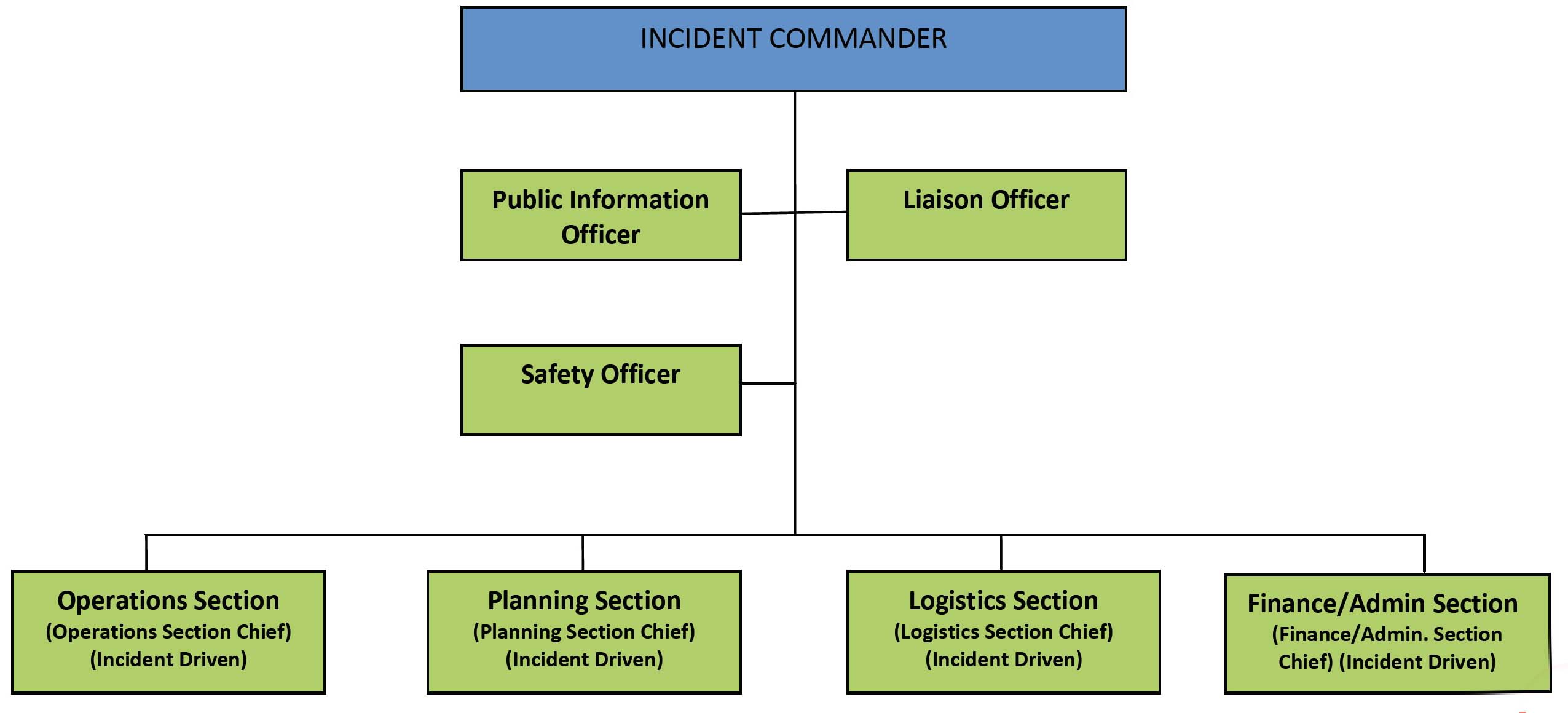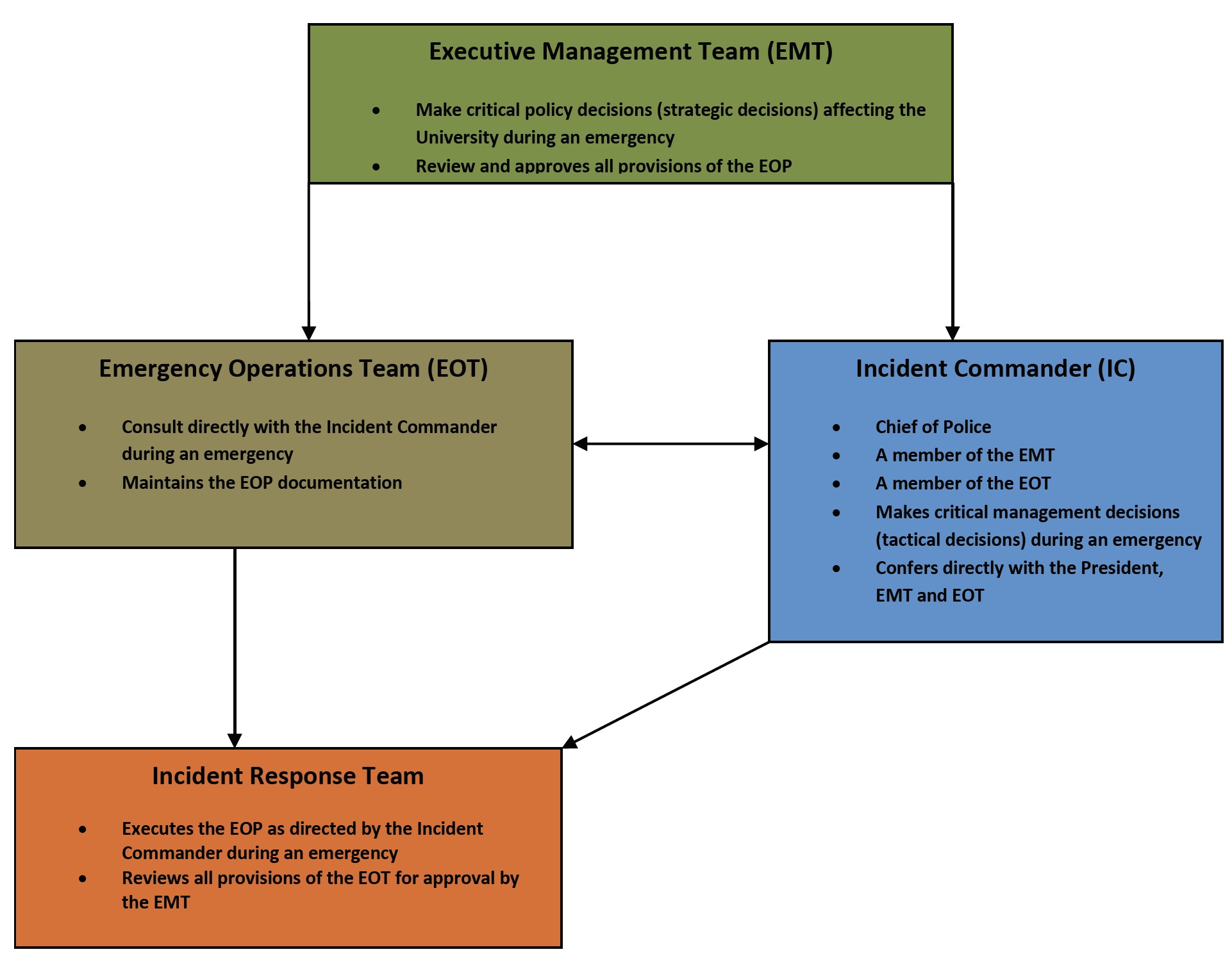The Emergency Operations Plan (EOP) is not intended to establish policies, but to create a framework that will allow an immediate response to an emergency without impeding the initial response or requiring policy decisions to first be made. This plan describes the roles and the responsibilities of the University’s personnel during emergency situations. The basic emergency procedures are designed to protect lives and property through effective use of university and community resources. Chicago State University’s EOP is a procedural document for organizing, coordinating and directing available resources toward the control of an emergency. The plan includes a chain of command establishing the authority and responsibility of various individuals. In emergencies, procedures sometimes must be changed at an instant’s notice; therefore, responsible and knowledgeable persons who know the procedures must have the authority to make necessary modifications. Through the use of Hazard –Specific Appendices (G-P), this Emergency Operations Plan addresses several specific types of emergencies on an individual basis, providing guidelines for the stabilization and recovery from the incident.
Emergency Operations Plan
|
|
Since an emergency may be sudden and without warning, these procedures are designed to be flexible in order to accommodate contingencies of various types and magnitudes. The purpose of this plan is to establish clear guidelines detailing the appropriate response to disaster and crisis situations. The goal of this plan is to limit the loss of life and property in the event of an emergency or crisis that affects the operations of Chicago State University. The proper use of available resources and personnel is critical to the successful management of the emergency operations. According to this plan, an emergency is defined as any event or condition that normal responses or measures cannot control. The President of CSU or his or her designated representative is responsible for declaring a state of emergency. Once this state is declared, all students, faculty and staff are to adhere to these guidelines. It is imperative to remember that these procedures are guidelines and should be used as a flexible tool in responding to a variety of contingencies.
University personnel and equipment will be utilized to accomplish the following priorities:
- Priority 1: Protection of Human Life
- Priority 2: Support of Health, Safety, and Basic Care Services
- Priority 3: Protection of University Assets
- Priority 4: Maintenance of University Services
- Priority 5: Protecting and Maintaining the Institutional Image
- Priority 7: Assessment of Damages
- Priority 8: Counseling or other necessary steps to restore well being on campus
- Priority 9: Restoration of General Campus Operations
This Emergency Operations Plan is predicated on a realistic approach to the problem(s) likely to be encountered during a major emergency or disaster. Hence, the following assumptions are made and should be used as general guidelines in such an event:
- An emergency or a disaster may occur at any time of the day or night, weekend, or holiday with little or no warning.
- The succession of events in an emergency or disaster is not predictable; therefore, published operational plans, such as this plan, should serve only as a guide and a checklist, and may require modifications in order to meet the requirements of the emergency.
- An emergency or a disaster may be declared if information indicates that such conditions are developing or probable.
- Disasters may be community-wide. Therefore it is necessary for the University to prepare for and carry out disaster response and short-term recovery operations in conjunction with local resources
This plan identifies four emergency levels as follows:
- Level 0 Covers a short-term internal "routine" emergency involving only university facilities and employees. Limited outside agency involvement may be required.
- Level I Includes an emergency with a predictable duration at a single site involving the university and a single outside agency such as the fire department.
- Level II Involves an emergency with an unpredictable duration with a multi- agency response.
- Level III Relates to a widespread emergency impacting a large segment of the university with long-term implications. The following level definitions should be used as a guide to defining the magnitude of an emergency incident and the potential impact on Chicago State University.
The operational aspect of the University’s Emergency Response Plan is based upon the National Incident Management System (NIMS). NIM is a modular emergency management system designed for all hazards and levels of emergency response.
The organization of Chicago State’s EOT at the EOC is based on the Incident Command System (ICS) used by the Office of Emergency Management (EOM) and the regional and federal emergency response agencies. Under this model, members of the EOT are assigned to functional working sections to maximize efficiency as follows:
1. Planning Section
- Initiates, collects and verifies field reports,
- Assesses reconnaissance and other data,
- Prioritizes situation reports and plans, and
- Develops Incident Action Plans.
2. Operations Section
- Directs and coordinates all operations, and
- Receives and implements Incident Action Plans.
- The EOT of this section will depend on the type of incident and will be the Incident Commander essentially.
3. Logistic Section
- Obtains and stages resources in support of emergency operations.
4. Finance/Administration Section
- Tracks all incident costs, and tracks and manages the university claims process.

This system creates a combination of facilities, equipment, personnel, procedures, and communications operating within a standardized organizational structure. It is used by the Department of Homeland Security (DHS) and throughout the United States as the basis for emergency response management. The use of NIMS will allow the university to communicate and coordinate response actions with other jurisdictions and external emergency response agencies.
Some of the kinds of incidents and events that would be managed through NIMS are listed below:
- Fires, HAZMAT, and multi-casualty incidents
- Multi-jurisdiction and multi-agency disaster responses (natural disaster, terrorism, civil unrest)
- Search and rescue missions
- Significant transportation accidents
- Major planned events, e.g., celebrations, parades, concerts
Chicago State University Emergency Operations Plan
University response to a disaster or emergency will generally involve the following phases:
Planning and Mitigation: The process of evaluating exposures and developing or refining response plans that will assure an orderly and effective response to an emergency, and for identifying and mitigating areas of vulnerability. After every activation of the EOP, an after – action review will be performed by the Incident Commander or his/her designee to determine if the response was effective or if the plan should be modified and improved.
Response: The reaction(s) to an incident or emergency in order to assess the level of containment and control activities that may be necessary. During this phase, generally only preliminary forecast of the impact will be available, and university objectives will be to assure the public welfare, protect critical infrastructures, and provide support to emergency response organizations/ operations.
Resumption: The process of planning for and/or implementing the resumption of critical business operations immediately following an interruption or disaster. During this phase, more in-depth forecasts of the impact will be available, and university-wide objectives for program resumption will be determined. All response activities indicated above will continue as necessary.
Recovery/Restoration: The process of planning for and/or implementing recovery of non-critical business processes and functions after critical business process functions have been resumed, and for implementing projects/operations that will allow the university to return to a normal service level.
Organizational Components
The University’s EOP consists of six (6) major elements:
- Executive Management Team
- Emergency Operations Team
- Incident Response Team
- Appendices (A – F)
- Hazard – Specific Appendices (G – P)
- Functional Annexes (ESF#1 – ESF#10)
The primary responsibility for monitoring emergency threats and events resides with the Chicago State University Police Department. CSUPD operates on a continuous 24/7/365 basis and is always available to receive emergency communication from a variety of official and public sources. In any type of emergency, the CSUPD Shift Supervisor (Watch Commander) should follow standard operating procedures. If the emergency warrants, he/she should communicate immediately with the Chief of Police. If the Chief of Police is not available, CSUPD will follow established order of succession procedures. Based on information obtained from appropriate entities, the Chief of Police will initially declare the level of the emergency and may activate portions of the Emergency Management Plan to the extent necessary to control the situation.
The university coordinates its emergency preparedness planning with the City of Chicago, and other adjacent localities, agencies and organizations to ensure that the campus procedures are consistent with current government practices, and that Chicago State University is able to maintain effective emergency communications and coordination during an incident. This plan is promulgated under the authority of the President of the University. All decisions concerning the discontinuation of university functions, cancellations of classes, or cessation of operations rest with the President or his/her designee. After consulting with the Incident Commander and appropriate members of the Executive Management Team, the President or his/her designee shall be responsible for declaring any major institutional emergency. CSU’s EOP partitions emergency decision makers into functional teams to maximize efficiency.
Executive Management Team (EMT) is composed of lead administrators who establishes the policies and procedures as needed to support emergency operations, and determines business recovery and resumption priorities.
Emergency Operations Team (EOT) is activated based on the type and nature of the incident, to manage the operational aspects of the University’s response to an emergency event. The University Incident Commander heads the EOT and is responsible for overall management of the incident.
Incident Response Team (IRT) is activated based on the type and nature of the incident and is organized under the Incident Command System (ICS), headed by the Incident Commander.

The full (confidential) version of the Chicago State University Emergency Operations Plan contains the following Emergency Support Functions (ESF), which comprises specific roles and responsibilities, procedural outlines and checklist, and key information related to the specific topic areas.
ESF #1 Direction and Control
ESF #2 Communications
ESF #3 Emergency Information /Emergency Operations Center (EOC)
ESF #4 Public Information
ESF #5 Disaster Intelligence
ESF #6 Evacuation
ESF# 7 Mass Care
ESF #8 Health and Medical
ESF #9 Mortuary Services
ESF #10 Resource Management
 The Chicago State University Emergency Operations Plan is available on the web site
to the entire CSU Community. The goal of this plan is to limit the loss of life and
property in the event of an emergency or crisis that affects the operations of the
University.
The Chicago State University Emergency Operations Plan is available on the web site
to the entire CSU Community. The goal of this plan is to limit the loss of life and
property in the event of an emergency or crisis that affects the operations of the
University.
 All Rights Reserved
All Rights Reserved